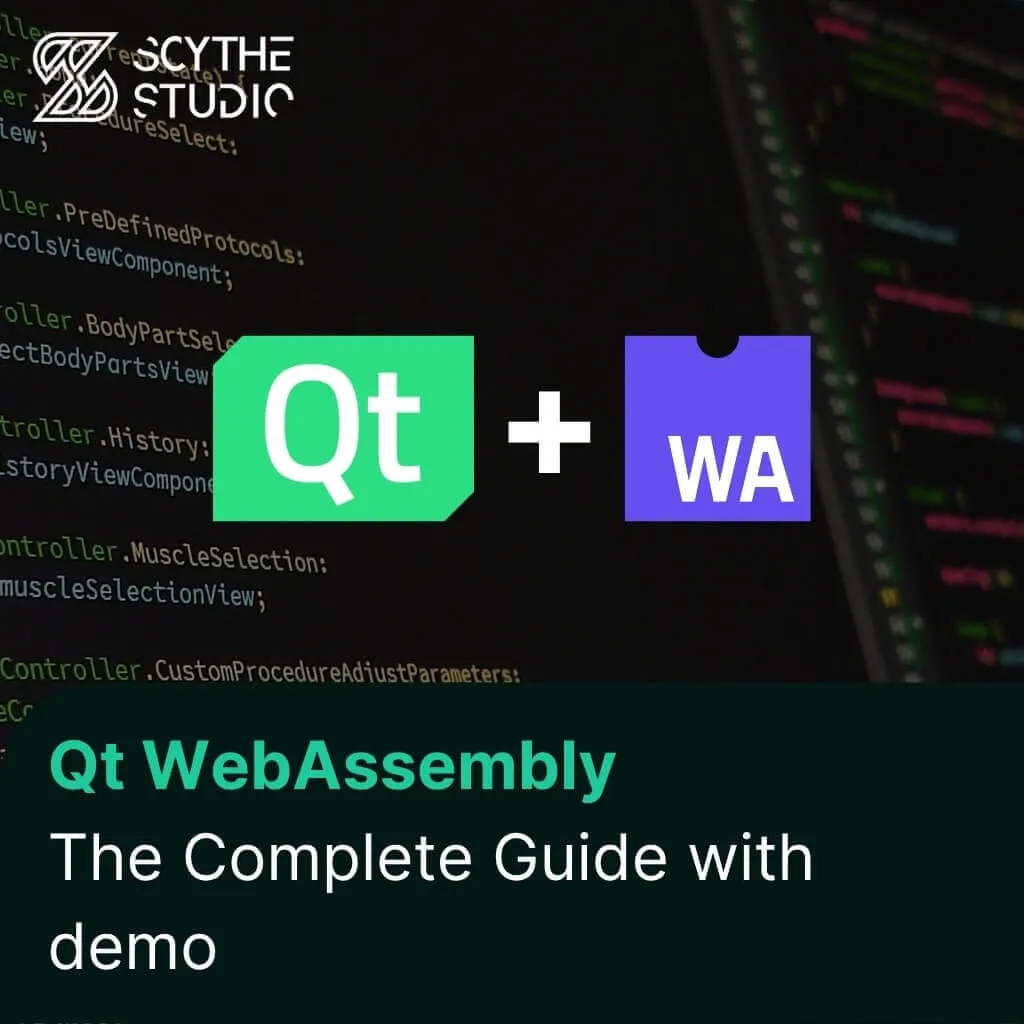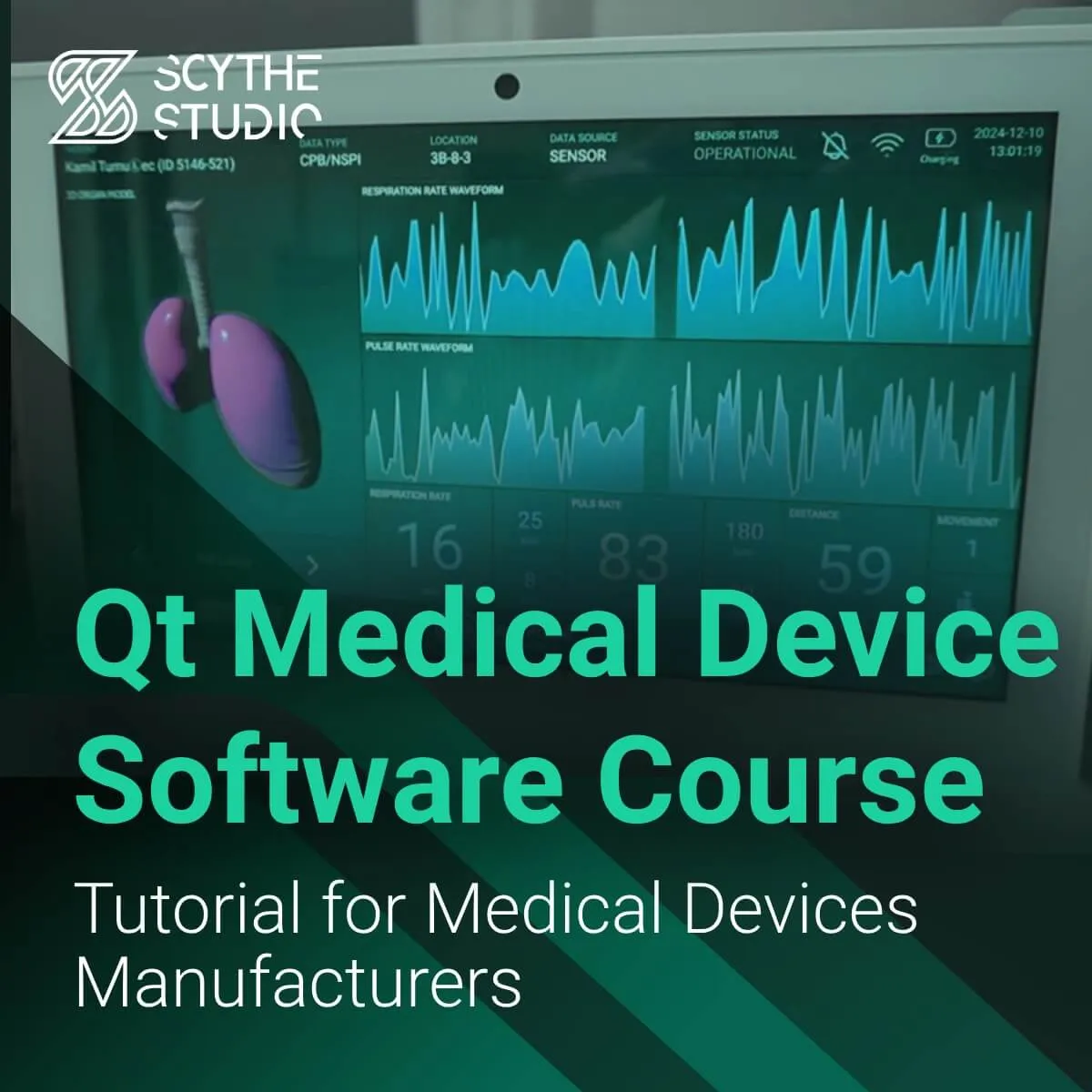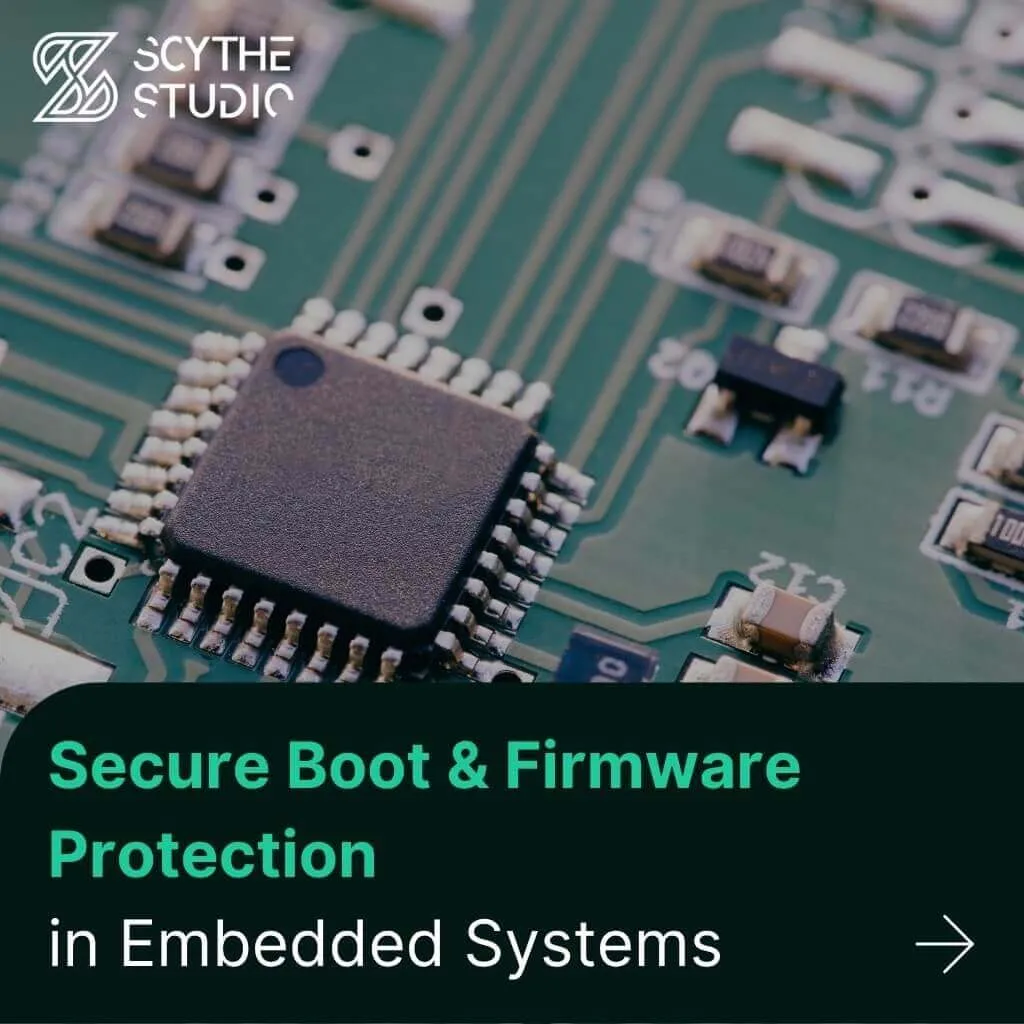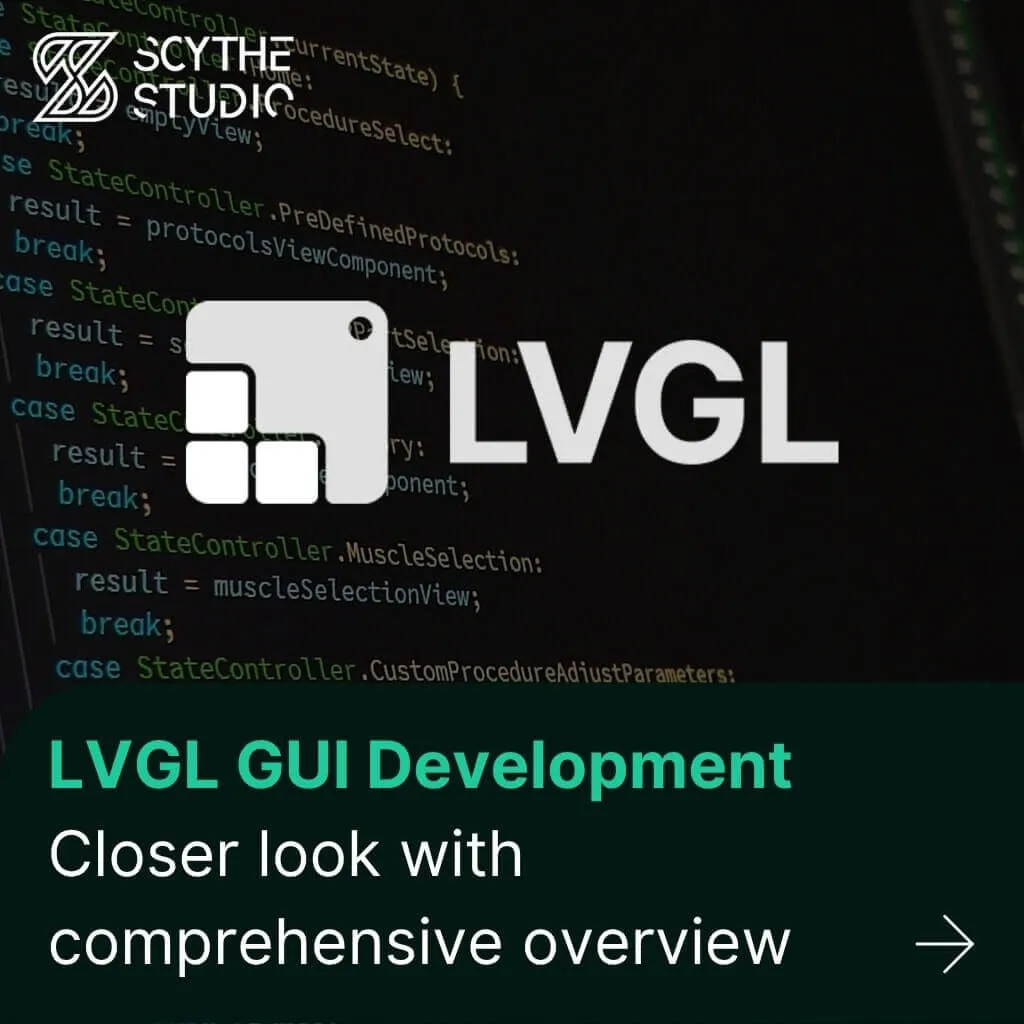
How to use Qt WebAssembly – The Complete Guide with demo
Hey, welcome back to another blog post. Today we’re going to talk about the new Qt WebAssembly. This post will […]
Join us at Qt C++ Warsaw Meetup - 21.08.2025
Sign up for free!
The development process of a new medical device has been a challenging venture for both medical startups and also big companies being in the MedTech industry for decades. Medical device manufacturers of all kinds constantly look for tools and technology that will make their system, their software, and their user interface prominent among other competitive devices.
One of the solutions that allows effective UI development is the Qt framework which plays a crucial role in developing user-friendly medical devices. It is a technology that has supported embedded developers for years and will do that for a long time in the future.
This article is an announcement of the next great thing for MedTech professionals that we built – the Qt Medical Device Software Course. I prepared the course from start to finish (except video editing, thank you Andrew!) and you have to know that it was not only the opportunity to share insights from someone who participated in building over two dozen medical devices, but also pure enjoyment.
The beginning of the year is a great time to grow, learn, and find out new things. So do yourself a favor and watch our Qt Medical Device Software Course. You can watch it in under two hours if you take notes!
 Qt Medical Device Software Course on YouTube
Qt Medical Device Software Course on YouTube
In this article, I will write more about Qt, medical device UI design, and developing medical projects in general, but let me introduce you to the content of the tutorial first. Okay, so it has to be stated that this course is not a user interface design or coding tutorial.
We will not explain to you how to use Qt tools and how to run Qt software as these topics are the same for all sectors in which Qt is used (let it be automotive, industrial, and so on). We already have another YouTube series about Qt coding.
 Frame from one of the films. That’s how course looks.
Frame from one of the films. That’s how course looks.
This course focuses on aspects that make sense for medical device development. Therefore the content is technical enough so all the stakeholders understand how Qt supports them in building their medical system. So you will find there the following episodes:
Introduction to Qt and why to use it for medical device development – the longest episode that explains all the characteristics of Qt that matter for healthcare and its advantages but also disadvantages;
Choosing Embedded Target – an important aspect of medical software projects that also matters for UI design is a choice of hardware platform. Advanced visual effects and all the graphical trends will not run on cheap MCU. On the other hand, if we build wearable health tech devices with small screens, then users are okay with just clean and intuitive UI;
Operating System for Medical Device – Windows, Linux, or Something Different? You will be surprised which systems and computers manufacturers put in their medical devices;
Medical Device Architecture Best Practices – some principles and guidelines when it comes to designing a software project architecture that wouldn’t only correspond with the standards, but also address the regulatory aspects;
Connectivity – here I explain Qts connectivity modules, and the approach to HL7 FHIR, PACS, and cybersecurity. There is almost no device that wouldn’t be a part of a bigger system of connected devices. Not necessarily connected to the Internet, but rather to access other devices;
Qt DICOM Viewer – Medical Imaging with Qt – displaying CT, MRI, or X-RAY scans is a common case for medical software. In this episode, I explain how to approach this topic and hot to make patients scans appear on your screen.
Usability and Accessibility – this episode will cover medical GUI aspects and my tips that will help you design a user-friendly interface and an effective UX.
I had plans to record more, but I have a lot going on privately and company-wise. Nevertheless, it’s a great base for you!
 How to choose Embedded Target
How to choose Embedded Target
When I sat down to create the course, I had the following audience in mind. I was thinking about either starting or already establishing a medical device producer who wants to implement software on top of their device. And of course, the device has to consist of a screen and UI.
I think that you will find this tutorial valuable if you are:
Founder or Co-Founder looking for knowledge;
CTO or Software Lead who researches better tool that enables effective medical device development;
Developer who got a task to create a visual layer for medical software or simply want to broaden their expertise.
Adopting best practices in software development and UI design ensures systems are intuitive for healthcare professionals, improving efficiency and patient care. This course offers focused insights to help you build reliable and compliant medical software with Qt.
What’s the best about this course in my humble opinion are the examples of real-life solutions to the problems, best practices on UI design, and case studies.
Let me put here a small interlude. I personally have a background as a Qt developer and my company has a lot of expertise in Qt programming, especially for the healthcare sector. 80% of our projects were about medical devices. That’s how we have quite a unique mix of skills that make us stand out among other providers: We know Qt, we build complete projects (design, embedded, web, mobile) and we know medical standards and needs.

These things lead to our quality indicators – We have ISO 13485:2016 and ISO 9001:2015 certified quality management procedures and we are also an official Qt Service Partner. If you need professionals to develop interfaces or complete solutions, take a look at our medical device software development offer.
Building a nice UI is all about meeting the needs of developers, users, and patients. For medical companies, it’s about building interfaces that are reliable, flexible, and user-centric. Let’s dive in.
In the fast-paced healthcare industry time to market is key. A GUI framework must support rapid prototyping and fast iteration so developers can refine designs quickly. This means a smooth development and high-quality medical applications.
Medical devices work in many environments from bedside monitors to complex systems in the operating room. They run on many OSs and hardware platforms. The GUI framework must be flexible, supporting everything from resource-constrained devices to high-performance machines without compromising functionality or design.
The ability to display critical information clearly is the foundation of GUIs. Whether it’s 3D imaging, shadows and blurs for depth, or precise rendering of patient data, the interface must handle advanced visuals seamlessly. This is especially important for applications like imaging scans or real-time vitals monitoring.
 Patient Monitoring System
Patient Monitoring System
At the core of a great medical GUI is user-centric design. From requirements engineering to final iterations the interface must be designed for the end user. Whether the user is a surgeon, nurse, or technician the product should be intuitive and easy to use so they can focus on patient care.
A well-designed medical GUI doesn’t just look good it feels natural to use. By prioritizing usability and intuitivity manufacturers can make their devices empower healthcare professionals not hinder them. This is covered in the final episode of the course where we go into depth on how to align UX/UI design with real-world needs.
The proper way to answer this question would be to tell you to watch the course 🙂 Only this way you get the truly big picture, but let’s take this topic here as well for completeness’s sake. Qt has its competitors, but stills at Scythe we consciously choose Qt as the base for most of our projects. So I believe that yes, it does.
Qt is a powerful framework for developing cross-platform applications with advanced UI design capabilities. It allows programmers to build interfaces that run seamlessly on various OS and hardware platforms, making it ideal for medical devices ranging from compact monitors to high-performance imaging systems.
 Platforms supported by Qt
Platforms supported by Qt
Thanks to the Qt Quick module, Qt supports rapid prototyping, enabling fast iterations and quicker time-to-market. Its rich graphical tools handle advanced visual effects like shadows, blurs, animations, or 3D rendering. And that’s only about interface design aspects.
 Qt Quick
Qt Quick
Qt extends beyond UI development, offering robust tools for backend logic, seamless connectivity, databasing, and more, making it a great choice for medical projects. In the course, I explain the other reasons to go with Qt for medical and you can find there its maturity, low technology stack, and traceable development process. As you probably know those aspects play a vital role in the regulatory process.
Admittedly, it has its supporters and opponents, but the facts are that when implemented correctly it allows to significantly improve UI design. The solution, for example, allows you to import a design from Figma and merge it with the application logic there.
Well, that’s all for this article. I hope you have a look at my course and share some feedback how you liked it and which topics would you like to get covered in the future. At the end let’s summarize by answering the question of how to tell whether a particular technology is the one to go.
Once upon a time, I wrote another blog post titled “How to Choose The Right Technology for Healthcare Software Development?“. While not only about the UI, this blog post highlights the important factors. Well, to keep it simple. To my opinion, the best solution is the one that we or our team knows the best. Of course, as long as it fulfills our needs.
If we go with something then we don’t have enough expertise and we simply replace old problems with new ones. So my recommendation is to give Qt a try if you:
evaluate tools for a new device or device’s new generation;
miss features in your application that you can’t implement using the current tool;
have huge technical debt and slow development that is not only frustrating but affects your business.
Feel free to consult with us whether Qt is applicable to your case and I wish you that every and each hospital, treatment or operating room in the world has your device inside!
Let's face it? It is a challenge to get top Qt QML developers on board. Help yourself and start the collaboration with Scythe Studio - real experts in Qt C++ framework.
Discover our capabilities
Hey, welcome back to another blog post. Today we’re going to talk about the new Qt WebAssembly. This post will […]

Users of embedded devices – from industrial controllers to consumer electronics – are often unaware of hidden vulnerabilities that threaten […]

Graphical user interfaces (GUIs) are becoming more and more important in embedded devices – from home appliances to medical equipment […]